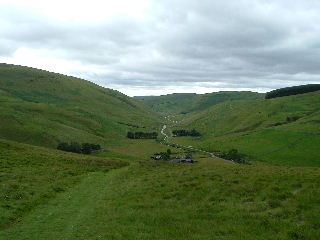 The beautiful and desolate
Coquetdale Valley in Northumberland.
The beautiful and desolate
Coquetdale Valley in Northumberland. The beautiful and desolate
Coquetdale Valley in Northumberland.
The beautiful and desolate
Coquetdale Valley in Northumberland.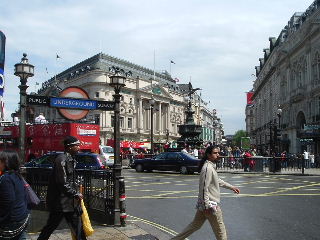 From Piccadilly Circus, a
few of the 7 million inhabitants of London. The statue known as Eros is
actually the Christian Angel of Charity.
From Piccadilly Circus, a
few of the 7 million inhabitants of London. The statue known as Eros is
actually the Christian Angel of Charity.
In early 2004 I had the wonderful good fortune to meet someone who shared my enjoyment for hill walking and scruffy little dogs. My friend, a Geordie, made me welcome on the Newton Farm and introduced me to a life that was very remote from the one I knew in California. This adventure starts out in the North of England and winds up down near London. Here are some of my experiences that happened along the way.
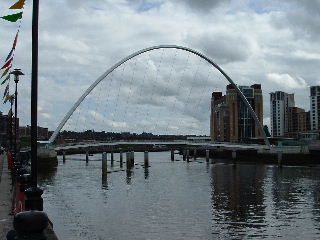 The Blinking-Eye foot-bridge
linking Newcastle and Gateshead over the River Tyne.
The Blinking-Eye foot-bridge
linking Newcastle and Gateshead over the River Tyne.
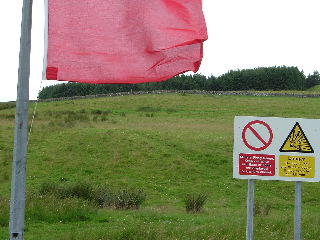 Signs of the Army at work
in Northumberland National Park.
Signs of the Army at work
in Northumberland National Park.
Just a little background first.
The Newton Farm is in Northumberland in the North of England. The largest city is Newcastle on the Tyne River. When I first arrived I wasn't even sure if they were speaking the same language. Most people, even in Britain, have trouble understanding the Geordies. Despite their eccentricities, they are some of the friendliest and most generous people I've ever met.
The most common explanation for the etymology of the word Geordie seems to come from their support of the Hanoverian King, George I. "The wee German Lairdie", as the Scots called him, was often sending the English army to protect Newcastle. After all, the Scots had held Newcastle on a couple of occasions in the 1640's. Back in those days and up to the 20th century, Newcastle supplied coal to the rest of Britain. The phrase 'bringing coals to Newcastle' implies doing needless work since there was plenty of coal there already. The pits are all closed and the Geordies are now known for their ability to drink. In addition to the vast quantities of alcohol they can consume, they have another reputation which, as far as I know, is unmatched anywhere else in Britain. It is the ability of young women to wear the skimpiest, most revealing clothing on the coldest nights. In fact, the worse the weather, the less you'll find them wearing both in and outside the pubs. "Wee aye, leyk!", it's a strange world in Newcastle.
It's easy to get out of Newcastle along the A1 heading North towards Scotland. If you keep going, in about 25 miles you'll reach the town of Alnwick (pronounced "Anic"). This is the home of the Duke and Duchess or Northumberland, and Alnwick Castle where Harry Potter played his first game of Quidditch in the movie. The Alnwick Castle Gardens, designed by the Duchess of Northumberland, are beautiful. The tree house is well worth a visit for tea. Entry is by a rope bridge. Before getting to Alnwick, however, we head off to the west towards Newton Farm and Northumberland National Park.
Northumberland is the least populated county in England. You'd have to go as far as the Highlands in Scotland to find somewhere less populated. In both you'd easily be outnumbered by sheep. The Newton Farm borders Northumberland National Park which is considered, by Defra (The Department of the Environment, Food and Rural Affairs) as an area of outstanding natural beauty. It's also considered a great place for target practice by the military. The guns used for target practice must be huge judging by the noise they make and the size of the spent shell casing on the mantelpiece at the local pub. One evening the army even lit the firing range with flares during target practice. The flares descended slowly by parachute amidst the artillery fire. If you didn't know otherwise you might think a fleet of UFO's was invading the Coquetdale Valley.
The artillery guns weren't the only noise in the countryside. Almost every day there would be low-level fighter jets. Usually they traveled in pairs and would fly quite close to the farm. On one occasion I remember hearing them coming and had just a few seconds to put my head outside the window to see and feel the whole building shake as they passed right overhead. The cottage I was in had stone walls several feet thick and to feel them vibrate from the sound of the jets was quite exciting. Although we weren't on the receiving end of those jets, it was a sobering thought that someone, somewhere would be. That place would probably be Iraq and it would be more than the sound they would have to deal with.
The proximity of the armed forces provided a daily reminder, even in the remote Coquetdale Valley, that the war in Iraq was real and not something to be taken lightly. It's a lot easier to forget this when you're in the City and insulated from what the army does for a living. But the City holds its own dangers.
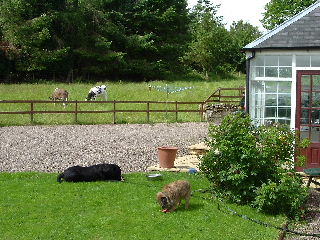 Cows and dogs hard at work on
the Newton.
Cows and dogs hard at work on
the Newton.
 I've just read 'Animal Farm' and have some ideas.
I've just read 'Animal Farm' and have some ideas.
 The Newton Woods, dark even on a
bright winter's day.
The Newton Woods, dark even on a
bright winter's day.One of the interesting sightings we'd see at dusk in the Summer were bats. Tiny little black silhouettes against the dark blue of the fading light. They seemed to come very close but are fabulously swift and agile flyers. They were lovely to watch as they fed on insects.
Another mysterious animal lurked nearby in the woods. It made an eerie noise that came from the woods across from Stable Cottage. Although I was assured it was safe, I never went in there at night. It didn't help that people referred to them as The Blair Witch Woods. There were numerous times I'd be walking the dogs late at night. The woods were just at the side of the road and I'd hear a shriek and rustling from deep inside. The first time that happened I was sure that the Blair Witch Woods would have me. Fortunately the Wood Pigeons were not the man-eating variety and I eventually got used to their blood curdling cries.
The Newton is a mixed arable and livestock farm. The nearest village is a few miles down the road. In all, 6 families live on the farm. Some of the buildings have been sold off over the years. The one I lived in with my friend was originally the cow barn, now converted to a cottage. The kitchen is where the bull was kept. The main farm building is occupied by a couple of retired physicists. Three cottages look out over the lower field and house the two sons and their families. The parents do a wonderful B&B at Parsonside just down to road from the cottage. On the farm there's no shortage of animals. They're everywhere and you know it because you're always stepping in something you wish you hadn't. Bed and Breakfast is also provided for bovines although the accommodation is a bit draughtier than Parsonside. Often farmers here will hire out spare capacity in their barn to help a herd through the winter.
They grow a mixture of oil seed rape, wheat, barley and a mixed hybrid called triticale (a wheat and rye hybrid that has the yield of wheat and disease resistance of rye). The sheep were mostly Cheviots which have a distinctive face like a mouse. For most of the year they were just fluffy animals in the field. But from March to April they would be brought into the large barn for lambing. The ewes are all scanned by ultrasound so they know how many lambs to expect. It's a terribly busy time of year for the farmer who has to spend most of the time, day and night, down near the lambing shed. He stays in the caravan that fortunately has a television that gets Formula I racing. A lot of the births happen at night and there is something about a little lamb being delivered by this seasoned farmer that will just take your breath away. Most of the lambs do just fine with their Mums and if the weather is good will get put out in the pasture the next day. The lambing I saw was in horrible weather so they had to stay inside an extra day and the lambs got a little clear plastic, biodegradable, raincoat to wear out in the field.
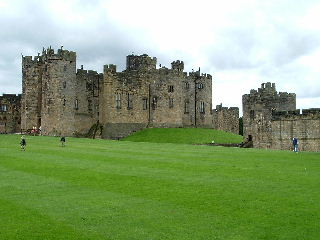 Alnwick Castle. Anyone for a quick game of Quidditch?
Alnwick Castle. Anyone for a quick game of Quidditch?
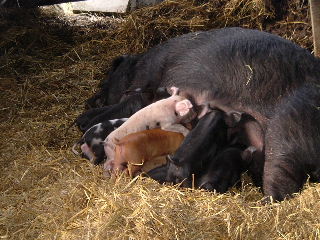 Feeding time ...
Feeding time ...
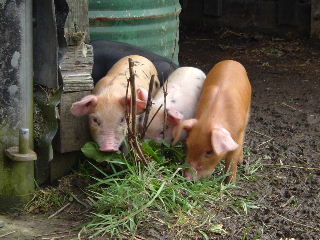 ...followed by play time.
...followed by play time.
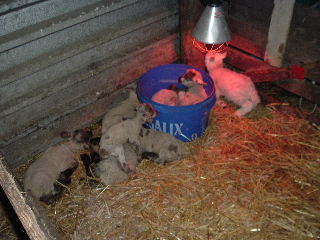 Orphan lambs waiting to be fed.
Orphan lambs waiting to be fed.
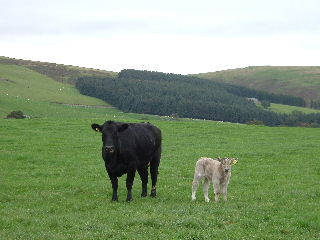 Mum with calf. Stay clear.
Mum with calf. Stay clear.
 Limousin and a Belgian-blue. They want to
play too.
Limousin and a Belgian-blue. They want to
play too.
The cows give birth at almost any time of the year. The calves are wonderful, but they say that more people are killed each year by getting between a cow and her calf than by bulls. The calves on Newton Farm were raised for their meat.
The pigs originally consisted of Doris and Delilah, two Oxford Sandy and Black sows. They were very tame which is fortunate because the electric fence that was meant to keep them in the paddock got knocked over on a regular basis. When they broke out they would either head for the cattle feed or down the road. It's just good luck that neither of them was ever hit by a car. Although there wasn't a lot of traffic by the Newton, the traffic that did pass through that area usually went quite fast. Barney was a huge and gentle boar that sired several litters from both sows. Each litter was about 12 or 13 although it was hard to count exactly how many piglets there were. Some of those piglets have since been sent to the abattoir and have produced some lovely, although I've never tried it, pork loin and sausages.
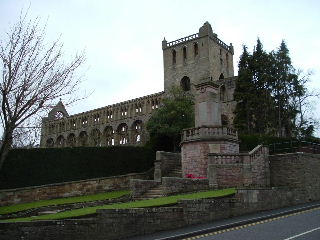 Jedburgh Abbey and the cenotaph.
Jedburgh Abbey and the cenotaph.Scotland and the Borders are very close, in fact you can see them from the back field through the Blair Witch Woods. There are four abbeys in the Scottish Borders: Kelso, Jedburgh, Dryburgh and Melrose and they're all beautiful in their own way. Sir Walter Scott is buried at Dryburgh. Melrose has some of the best butcher shops and lovely walks either along the Ettrick water or up the Eildon Hills. But Jedburgh was where we often headed on the weekend. One of the very best coffee shops you'll find is on the High Street, called Simply Scottish.
The abbey thrived under the monastic order of St. Augustine in the 12th and 13th centuries. That was a time when the lands of Northumbria and Newton Farm would have been in Scottish hands. However, the Wars of Independence and Henry the VIII's split with Rome saw the final destruction of all the abbeys in the mid-1500's. The disputed borders were eventually returned to English rule although for many years it was a lawless area where bandits and Border Rievers robbed and stole from whoever they could.
Mary, Queen of Scots house is in Jedburgh. The abbey, just a short walk away, would have already been damaged in the Reformation when she lived there in 1566. In many ways her life was tragic. She became Queen of Scotland six days after her birth when her father (James V) died. Her Mum, Mary of Guise was the daughter of Margaret Tudor who was, in turn, the sister of Henry VIII. She sent Mary Stuart off to France to live with the royal family where she would have spoken French rather than her native tongue. The pressure on her must have been tremendous and she sought advice from some people that didn't always have her best interests in mind. She must have felt a great love for Scotland and wanted to rule her people. Since Roman Catholics also considered her Queen of England, it meant that there would ultimately be a clash with her cousin, Elizabeth I. Elizabeth, was torn between her genuine feelings for Mary on the one hand and wanting to keep Britain from disintegrating into a civil war between Protestants and Catholics, on the other. After keeping Mary under house arrest for many years, Elizabeth, probably reluctantly, had her beheaded in Fotheringhay in 1587. She now lies interred in Westminster Abbey in London.
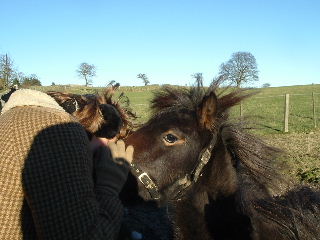 The Fell-Pony Whisperer.
The Fell-Pony Whisperer.
 Hill walking in the borders of England and Scotland.
Hill walking in the borders of England and Scotland.
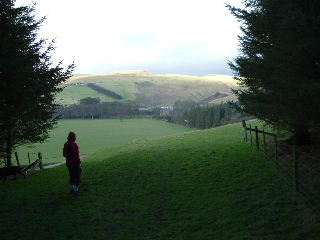 "If life were like a day in June, And we had choice of England wide, Who would not
spend and afternoon, And evening too, by Coquet-side." - D.D.Dixon, 1903
"If life were like a day in June, And we had choice of England wide, Who would not
spend and afternoon, And evening too, by Coquet-side." - D.D.Dixon, 1903
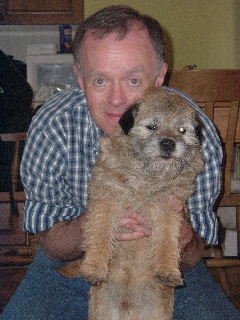 A scruffy and smelly one.
A scruffy and smelly one.
Midway between Oxford and Cambridge lies the new town of Milton Keynes. After WWII its roads were laid out in a right-angle grid system and a herd of concrete cows planted in the northern part near where I lived. The roads are so regular that it was sometimes hard to determine where I was because there were no distinctive landmarks. I got dizzy negotiating all the roundabouts on my way home to Stony Stratford.
The old town of Stony Stratford is pleasant even though it has its share of vandalism and graffiti. At least you can have a peaceful walk along the River Ouze or the Grand Union Canal. Shakespeare even mentions it in Richard III (Act II, Scene IV, "Last Night, I heard, they lay at Stony Stratford"), but it is most famous for the Cock Hotel and Bull Hotel on the High Street. The phrase "Cock and Bull story" arose from the stage coach drivers who would try and outdo each other with tales of speed and daring coming up from London and stopping here for the night.
Bletchley is now mostly known for its Tesco, ASDA and Ikea Superstores. But in the Second World War it was where the code breaking efforts were concentrated. Alan Turing is one of the more famous people to have worked at Bletchley during the war. It was home to thousands of Wrens (Woman's Royal Naval Service), engineers, scientists and mathematicians, all trying to either break the German secret codes, or in turn deceive the enemy. An ingenious plot that was made public involved diverting the German's defenses from Normandy on D-Day. It involved planting false papers about the invasion on a corpse and then launching the corpse from a submarine off the Spanish coast. It was found by the Germans and was, in part, responsible for D-Day being the success it was. Operation Mincemeat was written about in a book and made into a movie, both called The Man Who Never Was.
It did seem funny going to Tesco in the evening knowing that it was just a mile or so to Bletchley Park where all that talent had been assembled during the war.
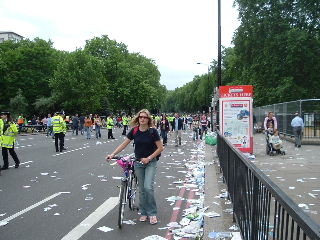 Live8 would tackle world litter another
day.
Live8 would tackle world litter another
day.On Saturday, 02Jul2005, I took the Silver Link train, as usual, from Milton Keynes to Euston Station. It was a beautiful day and I could follow the noise and helicopters from the train station to Hyde Park when Bob Geldof's Live8 concert was going to be staged. It was very crowded and lots of people who didn't have tickets just sat outside the park to listen. After getting swept along with the crowd for a mile or so I headed over to Green Park and through a tiny passage called Milk Maid's lane towards St. James Palace.
...London was bombed. The number of casualties was small compared to the World Trade Center tragedy, but the pain caused on an individual level was just as horrific. The bus that was bombed was, ironically, outside the British Medical Association on Tavistock Square. From Euston Station it's a five minute walk; a walk I did regularly. I remember taking the train into Euston 48 hours after the bombing. I was angry and defiant that anyone should try to stop us going to London. The bombers didn't strike terror in me or my fellow travelers, just a determination to get on with things. The top of Woburn St. was by now screened off from the public so the forensic work could take place. The Edgeware Road tube station was closed and would remain closed for the foreseeable future. I walked off in quiet reflection towards the British Museum in Bloomsbury by way of the University of London. Briefly I thought I glimpsed the spirit that saw London through the blitz and why no enemy would ever defeat the British with bombs.
One of the great pleasures of London is surely Covent Garden. Originally designed by Inigo Jones in the early 17th century, its long history as a market for fruit and vegetables has, in modern times, been taken over by boutique shops, market stalls and some of the best street performers you'll find. I was mesmerized by Terry St.Clair who played acoustic guitar near the London Transport Museum. He's got an interesting life story and writes some amazing songs about life, about London and sometimes both. His CD, Black and White is one of the best purchases I made in London. All his songs are done in one take which gives them a wonderfully authentic feeling compared to some of the sterile compositions we hear today.
On several weekends, a string quintet, students from a local college, were incredible at simultaneously playing and inducing a tiny bit of guilt in the passing patrons to support them. They played by the stairs down to the lower level and you got a great view of them from the gallery above. One of their friends would walk the gallery to pass the hat.
The Royal Opera House is around the corner and most important of all, the free toilets are at the opposite end of Covent Garden.
 Another of London's
Werewolves.
Another of London's
Werewolves.If you were around in the late 1970's you might remember this song by Warren Zevon. Sadly, he's gone now, but his wild flight of imagination lives on in those streets of London. In his song he takes you on a whirlwind tour from Soho to Buckingham Palace (to see the Queen) and on down to Kent.
After walking through the streets of Soho in the rain if you cross Shaftesbury Ave. into London's Chinatown can indeed get a big dish of beef chow mein at Lee Ho Fooks. In Elizabethan times, Soho was a little village on the outskirts of London. The term Soho came from the cry of the fox hunt to gather the hounds. Soho is now in London's West End and still retains its own distinct charm. There are the sex shops and peep shows which always take a few lost tourists by pleasant surprise. There are also many wonderful places to have a coffee and bite to eat. A short walk away on upper Brook Street, in Mayfair, was where Jimi Hendrix was overheard. They probably both walked those same streets of Soho. And I'll bet their hair was - perfect.
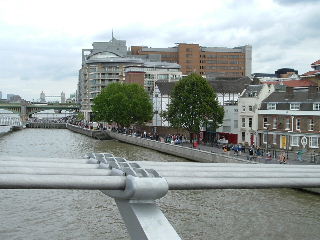 The Globe Theatre from the Millennium
Bridge. Tower Bridge is just visible in the background.
The Globe Theatre from the Millennium
Bridge. Tower Bridge is just visible in the background.
In High School, Shakespeare seemed to me distant and remote. But after seeing Kevin Spacey play the role of Richard II at the Old Vic, I was hooked. For less than £10 I got a front-row seat for one of the best plays I'd ever seen, of one of Shakespeare's most complex characters, in one of London's most famous venues.
The Old Vic is a bit removed from most of the West End theatres. It's located South of the Thames on The Cut near Waterloo International Railway station. It's International because this is where the Eurostar train leaves for the Continent. Not far away, in Bankside, is the new Globe Theatre. Shakespeare would surely have recognized it if he were alive today. It took an American actor, Sam Wanamaker, to campaign to have it re-built. It now stands in almost the exact spot as the original did in Elizabethan times.
In the early 1600's the theatre was very different from what we know today. On Bankside, for example, The Globe had competition from three nearby theatres: The Swan, The Rose and The Hope. Even though Elizabeth was a supporter of the theatre, the city elders, often Puritans, took a dim view of them. Theatres were often in close proximity of bear-baiting arenas, brothels and drinking houses. In addition, the elders placed strict rules governing what could be covered in a play. Topical religion or politics was frowned upon and depicting any living politician could cause the playwright to wind up in the clink (also on the South bank of the Thames). Sometimes, with good reason, the play houses would be shut down due to the plague sweeping through the capital, This happened on an alarmingly regular basis. After the death of James I (VI of Scotland, son of Elizabeth), plays were even banned by Parliament under the Puritan influence. Despite all these setbacks, it's a real testament to the universal appeal of the play that they thrive in the West End today. They can be enjoyed without fear of plague or imprisonment thanks to these early troupes and play houses and the "groundlings" who parted with 1d to be entertained for an afternoon.
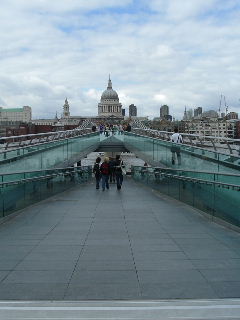 St. Paul's Cathedral would
have looked different in Shakespeare's time. The one we see today was designed by Sir Christopher Wren in
the 17th century.
St. Paul's Cathedral would
have looked different in Shakespeare's time. The one we see today was designed by Sir Christopher Wren in
the 17th century.
The play I saw was a historic tragedy about Richard II who lived in the later years of the 14th century. It's about his abuse of power and ultimately his downfall. The setting of the play was in modern times and could easily have portrayed some of our current political leaders. Over 600 years have passed since Richard II ruled and over 400 years since Shakespeare wrote it, yet it remains a prescient reminder of the fate of those who seek power and then abuse it.
 Blackfriars Bridge. The
Gherkin on the right is sometimes called the Swiss Re building.
Blackfriars Bridge. The
Gherkin on the right is sometimes called the Swiss Re building.
These are just some of the memories I have from Newton Farm, Scotland, Buckinghamshire and London. I am very grateful to the people and animals in the Newton for letting me share part of their life. My time there seemed too short but it left an impression on me that will last a lifetime. It truly was an adventure that, I know, will take me back there again one day.
Wherever you roam, I hope you'll get as much enjoyment as I did getting to know the people and places you visit. Maybe you'll walk some of the same paths I did in London or Northumberland.
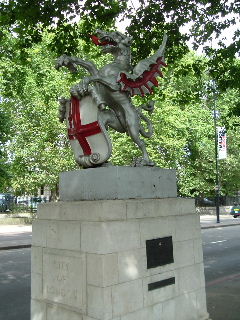 A fierce guardian of the City.
A fierce guardian of the City.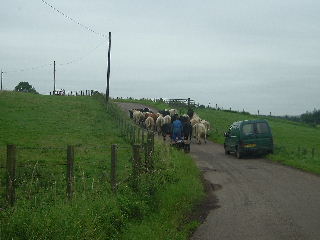 Rush hour at Newton Farm.
Rush hour at Newton Farm.